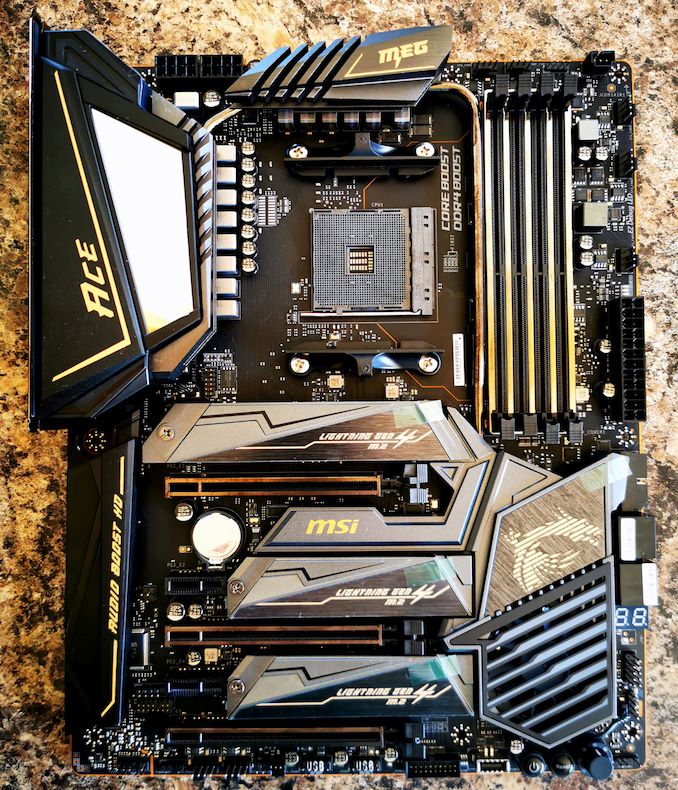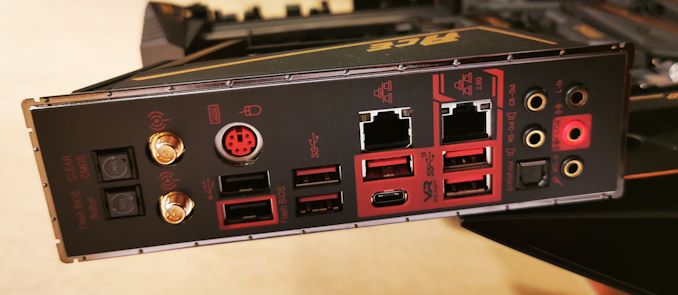The AMD X570 Motherboard Overview: Over 35+ Motherboards Analyzed
by Gavin Bonshor on July 9, 2019 8:00 AM ESTMSI MEG X570 Ace
Our full review of the MSI MEG X570 Ace is currently live with many more X570 models set to be fully reviewed and analyzed over the next couple of months.
The MSI MEG X570 Ace motherboard represents its premium MEG range and as we've seen from its range on the Intel Z390 chipset, MSI has followed the same naming structure for users to easily identify which each range signifies. The X570 Ace benefits from an Intel Wi-Fi 6 wireless interface, a Realtek 2.5 G NIC, three PCIe 4.0 x4 M.2 slots, and a 12+2 power delivery. Like all of MSI's X570 product stack with four memory slots, there is support for up to 128 GB of RAM.
The board has four DDR4 memory slots with support for up to DDR4-4600, three full-length PCIe 4.0 slots which operate at x16, x8/x8, and x8/x8/x4, with an additional two PCIe 4.0 x1 slots. Built into the X570 chipset heatsink is a cooling fan which uses MSI's Zero Frozr design as the X570 chipset has a rated TDP of up to 15 W. Providing power to the CPU is two 8-pin 12 V ATX power inputs, while the power delivery is using an extended 8 to 6.5 mm heat pipe which extends from the power delivery directly down to the chipset. The MEG X570 Ace has three PCIe 4.0 x4 M.2 slots, each with its own individual Lightning Gen4 M.2 heatshield which amalgamates into the boards black and gold designed heatsinks. Like the MSI MEG X570 Godlike, MSI's RGB Infinity Mirror 2 is present on the rear panel cover to allow users to customize the look of the board.
On the rear panel of the MSI MEG X570 Ace motherboard, there's a clear CMOS, and BIOS flashing button which has its own dedicated USB 3.1 G1 Type-A slot highlighted with a red outline. There are three USB 3.1 G2 Type-A ports, a single USB 3.1 G2 Type-C, two USB 3.1 G1 Type-A ports, and two USB 2.0 ports. Networking capability consists of a Realtek RTL8125AG 2.5 GbE NIC with the other Ethernet port being controlled by an Intel I211-AT Gigabit NIC. This model also includes integrated Wi-Fi with an Intel AX200 Wi-Fi 6 802.11ax wireless interface which also offers users with Bluetooth 5 connectivity. The five 3.5 mm audio jacks and S/PDIF optical output are driven by a Realtek ALC1220 HD audio codec.
The MSI MEG X570 Ace in terms of price and feature set is quite impressive and with an MSRP of $369 which makes it a highly competitive when compared with other models in its price range. The need for MSI to upgrade its networking capabilities on desktop motherboards is something they have started to implement, and the rear panel on the X570 Ace is also without video outputs so users looking to use Ryzen based APUs will need to look elsewhere.












225 Comments
View All Comments
DigitalFreak - Tuesday, July 9, 2019 - link
I think the only advantage of using a 2000 series CPU with an X570 board will be PCIe 3.0/4.0 support. The X370/X470 only supported PCIe 2.0. In theory, the connection from the 2000 processor to the X570 chipset should run at PCIe 3.0 speeds.FreckledTrout - Tuesday, July 9, 2019 - link
The x370 chipset and x470 both supported PCIe 3.0 with either a 1xxx or 2xxx Ryzen CPU. If you are not running a 3xxx CPU in the x570 board there isn't any major feature that should cause one to want to upgrade.DigitalFreak - Tuesday, July 9, 2019 - link
@FreckledTrout - Yes and no. The interconnect between the CPU and the chipset is PCIe 3.0 on X370 / X470, but all the PCIe lanes that come off the chipset are 2.0. Running a 2000 series CPU in an X570 board would give you a PCIe 3.0 link between the CPU and the chipset, with either PCIe 3.0 or 4.0 lanes coming off the chipset (depends on if AMD drops everything to PCIe 3.0 with a 2000 series processor).extide - Tuesday, July 9, 2019 - link
It looks like they still allow the chipset lanes to be 4.0. So you'd have 3.0 link to cpu, but 4.0 from chipset to devices.Targon - Thursday, July 11, 2019 - link
Since you have at least one or two PCI Express slots that are connected to the CPU, not chipset, that almost becomes a non-issue. On my Asus ROG Crosshair VI Hero(X370), you have PCI Express 3.0 x16 for the first slot, or x8/x8. The third PCI Express x16 slot is a 2.0 I believe, which is still enough to get the job done for many devices. Even with the X570 board with a first or second generation Ryzen processor, the most you end up with is an extra 3.0 supporting slot. Note that many boards may have x16 slots, but they are x8 electrically, so you won't see the full bandwidth anyway in those slots.sorten - Tuesday, July 9, 2019 - link
Thanks Gavin! This is a great resource and is exactly what I needed to help build my new system.willis936 - Tuesday, July 9, 2019 - link
The return of the 40mm fan! Those are the most obnoxious components ever. No one has missed them in the past ten years.Kastriot - Tuesday, July 9, 2019 - link
Buy Asrock aqua and problem solved.FreckledTrout - Tuesday, July 9, 2019 - link
I'm waiting for the next iteration of board for this reason. I'm speculating the next round the chipset will be on 7nm.abufrejoval - Tuesday, July 9, 2019 - link
The genious about that chiplet design is that the chipset doesn't actually benefit nearly as much from the shrink, as pure logic or SLC caches: The monolithic guys pay the 7nm overhead (e.g. EUV) for I/O while the geometry of the transistors in the I/O area is mostly determined by the need to power long motherbord or even slot traces.So while waiting is never a bad idea when your need clearly isn't overwhelming you, waiting for that shrink could turn out rather long. These days I/O heave chips might never be done in smaller geometries, because of that and because packaging has matured.